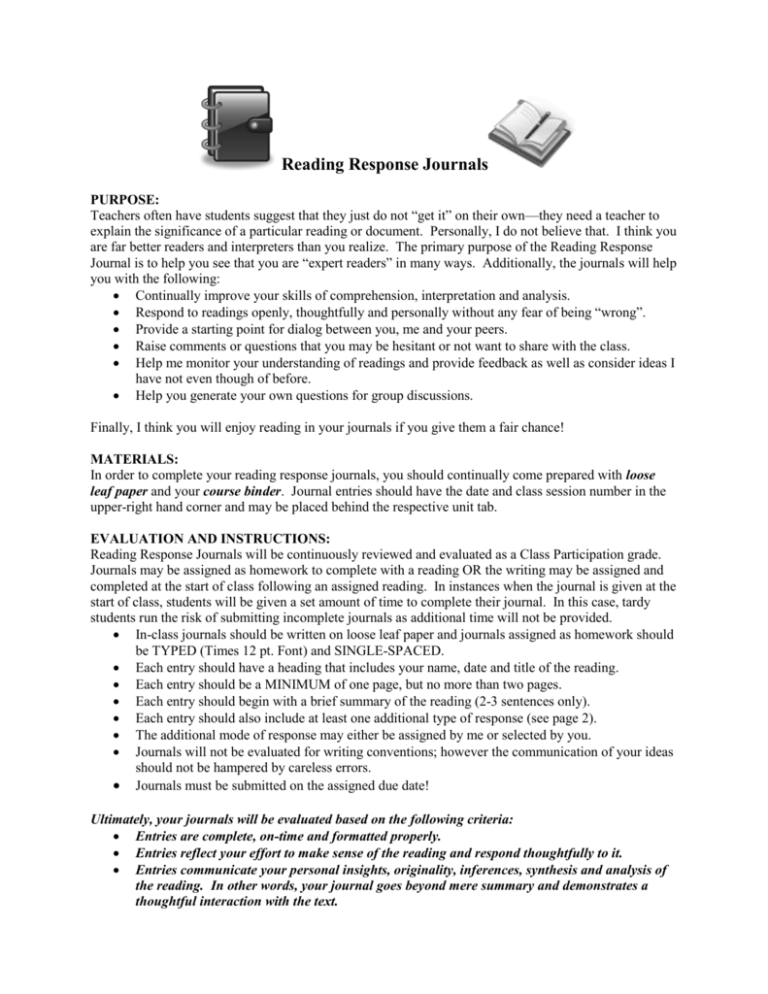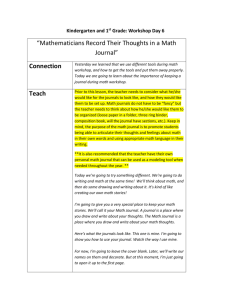Reading Response Journals
advertisement

Reading Response Journals PURPOSE: Teachers often have students suggest that they just do not “get it” on their own—they need a teacher to explain the significance of a particular reading or document. Personally, I do not believe that. I think you are far better readers and interpreters than you realize. The primary purpose of the Reading Response Journal is to help you see that you are “expert readers” in many ways. Additionally, the journals will help you with the following: Continually improve your skills of comprehension, interpretation and analysis. Respond to readings openly, thoughtfully and personally without any fear of being “wrong”. Provide a starting point for dialog between you, me and your peers. Raise comments or questions that you may be hesitant or not want to share with the class. Help me monitor your understanding of readings and provide feedback as well as consider ideas I have not even though of before. Help you generate your own questions for group discussions. Finally, I think you will enjoy reading in your journals if you give them a fair chance! MATERIALS: In order to complete your reading response journals, you should continually come prepared with loose leaf paper and your course binder. Journal entries should have the date and class session number in the upper-right hand corner and may be placed behind the respective unit tab. EVALUATION AND INSTRUCTIONS: Reading Response Journals will be continuously reviewed and evaluated as a Class Participation grade. Journals may be assigned as homework to complete with a reading OR the writing may be assigned and completed at the start of class following an assigned reading. In instances when the journal is given at the start of class, students will be given a set amount of time to complete their journal. In this case, tardy students run the risk of submitting incomplete journals as additional time will not be provided. In-class journals should be written on loose leaf paper and journals assigned as homework should be TYPED (Times 12 pt. Font) and SINGLE-SPACED. Each entry should have a heading that includes your name, date and title of the reading. Each entry should be a MINIMUM of one page, but no more than two pages. Each entry should begin with a brief summary of the reading (2-3 sentences only). Each entry should also include at least one additional type of response (see page 2). The additional mode of response may either be assigned by me or selected by you. Journals will not be evaluated for writing conventions; however the communication of your ideas should not be hampered by careless errors. Journals must be submitted on the assigned due date! Ultimately, your journals will be evaluated based on the following criteria: Entries are complete, on-time and formatted properly. Entries reflect your effort to make sense of the reading and respond thoughtfully to it. Entries communicate your personal insights, originality, inferences, synthesis and analysis of the reading. In other words, your journal goes beyond mere summary and demonstrates a thoughtful interaction with the text. TYPES OF RESPONSE: Occasionally, I will ask you to respond to a specific writing prompt (#12) or one of the additional response types outlined below. Other times you will be allowed to choose your type of response. Your choice may depend on your mood, what interests you or how you interpret the particular reading. I encourage you to try a variety of responses as you read. Remember, that each response must begin with a brief summary of the reading (2-3 sentences only). 1. QUESTION: Jot down questions about anything in the text that confuses you or seems unclear. You can question anything from the use of a single word to the meaning of an entire paragraph. Whenever possible, try to answer your question based on your interpretation and comprehension of the text, even if you do not think you are “right”. 2. REACT: Express your personal reactions to the writer, participants, information or ideas presented in the text. What do you like? What makes sense? What makes you angry? What bores you? What makes you sad? What makes you happy? Readings, especially primary documents and narratives, should be “felt” not just understood. 3. RELATE: Try to relate what you read to what you already know about ideas, people, the time period, personal experiences, historical events, future outcomes, etc. The more you can connections you can make with the reading, the more meaningful the reading will become. 4. REFLECT: What thoughts or associations does the reading inspire within you? What do you now think or believe that you did not think or believe before you read this work? What significance does the reading have for you personally? 5. MONITOR YOUR UNDERSTANDING: Note when you get bogged down in your reading, lose track of what the author is saying, feel the author has lost you. How did you get over your impediments to reading and understanding? When were you successful in comprehending and enjoying what you read? What parts of the reading were easy or satisfying? 6. ANTICIPATE: Active readers always try to predict what will happen next or in the future. Try to think how conflicts or problems within the reading will be resolved. 7. CONSTRUCT AND REVISE HYPOTHESIS: Making sense of any reading requires making and remaking hypotheses. Based on initial information, we form expectations about how individuals will act, how events will unfold, what the author has in mind, etc. As we read on, some of our hypotheses will be revised and some will be confirmed. Track your initial hypotheses and record their evolution as you read. 8. EVALUATE: Do you like what you are reading? What are the good and bad points of this work? How could it be improved? Does it have something valuable to say? Is it formulaic (i.e. like other works of its kind)? Is it worthwhile reading? 9. PRIORITIZE: What word, passage or idea is most important? Why? 10. ORGANIZE: Create a chart, diagram, map to help organize ideas, characters, places, key points from the reading. Briefly explain the purpose and structure of your creation. 11. CREATE: Compose a work of your own (poem, story, cartoon, artwork, play, etc.) in response to the reading. Explain how your creation relates to the reading and was inspired by the reading. 12. PROMPT: Respond to a specific question or prompt provided.




